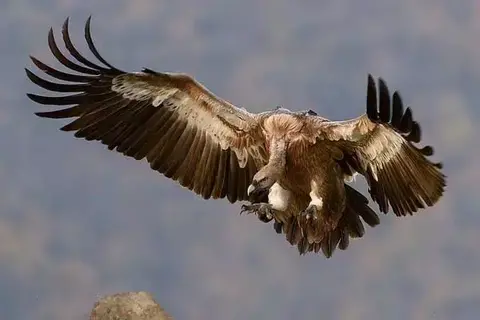50 Interesting Facts About Bumblebees
Karla MillerWe will tell you interesting facts about bumblebees. The solid bass whirring means there’s a bumblebee around. There is no need to be afraid of this insect, despite its terrifying stinging – bumblebees are usually not aggressive, and they will never attack people first if they are not disturbed again. But if you’re not lucky after all, you should bear in mind that their poison is quite unpleasant, perhaps even more unpleasant than the bees, not to mention that it can cause serious consequences for people with allergies.
Interesting facts about bumblebees
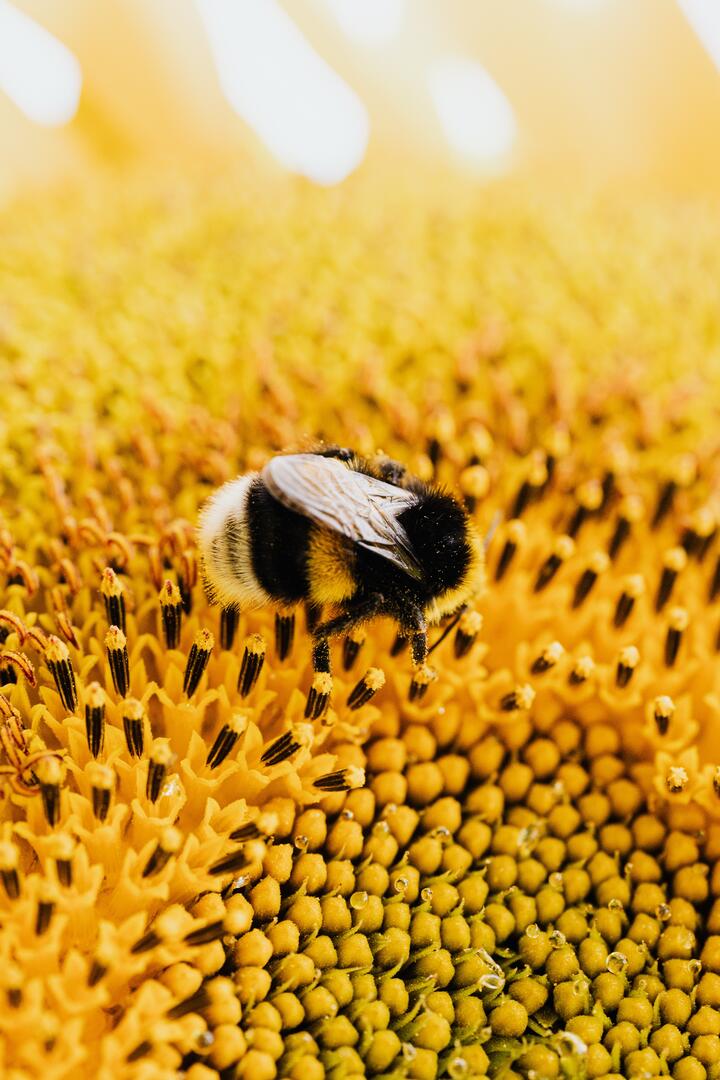 Photo by Karolina Grabowska on pexels
Photo by Karolina Grabowska on pexels1.Bumblebees are a genus of hymenopterous flying insects in the true bee family. Bumblebees are close relatives of honeybees.
2.Bumblebees live in the northern part of Eurasia and Africa, in North America. They are very good in mountains, forests, and fields. Not so long ago these furry insects were brought to Australia and New Zealand.
3.The time of the appearance of bumblebees is not exactly known. The earliest fossils of the bumblebee genus date back to the Oligocene (38 to 26 million years old), but the exact time of the group’s origin is still unknown.
4.The bumblebee fossil is a very rare find because it is very difficult for such a large insect to get into the resin to be completely enveloped by it and hardened into amber afterward.
5.The findings point to Asia as the place where bumblebees first appeared. To this day, that part of the world is home to the greatest diversity of bumblebees.
6.In all, scientists have counted more than 300 species of bumblebees and about 40 of their subgenera.
7.Externally, the bumblebee is very similar to the common bee, only it is larger, up to 2.5 centimeters in length, and more, its thick body is densely covered with hairs.
8.The back is dark, most often with yellow stripes, but sometimes the stripes are orange or red, pure black individuals without stripes are rare.
9.The insect’s body ends with a smooth sting without serrations, which is not visible in the usual state. On the back, they have 2 small transparent wings.
10.Bumblebees live in colonies of 50-200 individuals each. The colony consists of three types of individuals: females, workers (immature females), and males.
11.The founder of the family is the female queen, which is one of the few females that have been fertilized during the fall. In early spring (late April-May), the uterus starts nesting alone.
12.First, the queen finds a place for the nest. After covering the outside of the nest with moss or dry grasses, the female makes the first round wax cell inside. She places a small supply of food in the cell – a mixture of flower pollen and honey – and lays a few eggs. Having sealed this cell, the uterus builds the next ones.
13.A peculiarity of bumblebees is that, unlike other social bees, all larvae develop and nurse together, in the same cell. Under normal conditions, the female, after laying 200-400 eggs yielding workers, begins to lay eggs from which the female and male develop.
14.The nest cools and bumblebees have to work their pectoral muscles as hard as they can to maintain their temperature.
15.In the heat, you can also see a bumblebee fluttering with its wings at the entrance to the bumblebee’s nest. This time, however, the bumblebee is not doing it to raise the temperature, but to ventilate the dwelling.
16.Bumblebees, like bees, have venom, but, unlike bees, bumblebees do not leave stings in human skin. They can sting many times in a row.
17.Bumblebees prefer northern regions, which is not surprising because they are among the most cold-resistant insects. They can heat their body to a temperature of 40 degrees Celsius, which is necessary for the full life of the insect. For this purpose bumblebees use frequent and fast contraction of chest muscles.
18.Thanks to their developed thermoregulation, they can fly out to collect nectar early in the morning, when the air is still too cold and other insects are still sitting in their hiding places. As a result, the first nectar goes to these frost-resistant toilers.
19.Another factor that contributes to maintaining a normal body temperature is well-known, to anyone who has seen a bumblebee, fluff on the body. Thanks to it, heat loss is reduced by half.
20.A bumblebee family lives for one summer. In the fall, all the insects die, except for a few fertilized young queens, which spend the winter and begin to build a nest in April, laying eggs and starting a new family.
21.Bumblebee mothers that lay eggs are the largest, averaging 26 millimeters.
22.Working bumblebees, which complete and repair the nest and obtain food, are the smallest, up to 19 millimeters.
23.The males that fertilize the mothers are medium-sized, up to 22 millimeters.
24.Bumblebees are among the most cold-resistant insects. They are able, by rapidly and frequently contracting their chest muscles, to accelerate their bodies to the necessary 40 degrees Celsius. This allows them to fly out early in the morning and collect the first nectar when the air is not yet warm enough and gives bumblebees a definite competitive advantage over other insect species.
25.The bumblebee’s “fur” helps to keep warm – it reduces heat loss by half.
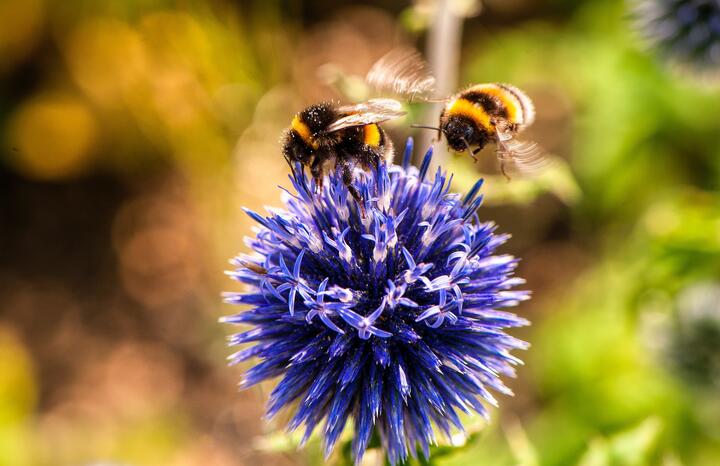 Photo by Michael Hodgins on pexels
Photo by Michael Hodgins on pexels26.Bumblebees build nests in the ground, leaf litter, hollow trees, birds’ nests, mole holes, mouse holes, squirrel holes.
27.Because of low aggressiveness bumblebees can be widely used in garden and garden plots.
28.There is even such a branch called bumblebee breeding – the breeding of bumblebees for pollination of crops to increase their yield.
29.Bumblebees are hovering tirelessly from flower to flower and are therefore valuable pollinators. They are especially important as pollinators of clover.
30.When clover was first cultivated in Australia, it bloomed well but produced no seeds. This went on until bumblebees were brought there from Europe.
31.Bumblebees develop in one generation. It takes an average of one month from the egg to the emergence of the adult insect. There are 4 stages of bumblebee development: egg – larva (develops 10-14 days) – pupa (develops 14 days) – adult insect.
32.After the first worker bumblebees appear, the mother rarely leaves the nest (her main duty is to lay new eggs). From the laid eggs, fertile females and males hatch closer to autumn. The males, having fertilized the females, soon die, but the females overwinter to start a new family the following spring.
33.Unlike honeybees, bumblebee nests do not hold much pollen or honey so that their population will not go hungry when inclement weather strikes.
34.Bumblebees in cold weather amicably “buzz” in the nest, raising the temperature to a comfortable 30-35 ° C.
35.It was noted long ago that in bumblebee nests before sunrise there is a “trumpeter”, which was thought to raise the humming of his fellow tribesmen to work. But it turns out that he just shivers from the cold. After all, in the wee hours of the morning the temperature at the surface of the soil drops severely.
36.There are so-called cuckoo bumblebees, which lead a parasitic lifestyle. Bumblebees are a subgenus of social parasites in the bumblebee family, which do not build their nests or collect pollen or nectar.
37.Bumblebees plant their larvae in the hives of other bumblebees. They also mimic their coloration.
38.Until recently bumblebees were considered a separate genus. This lack of need for food led to differences from other bumblebees: the hairs covering chitin are rarer and shorter; the proboscis is shorter; the chitinous skeleton is much denser, and there are no pollen-collecting baskets on the hind legs.
39.The worker caste of bumblebees is absent. To breed, the cuckoo bumblebee enters the nest of its host bumblebees, giving them about a month to develop beforehand. To find the nest, the parasite is guided by the smell emanating from the debris accumulated at the bottom of the nest.
40.The sound of their flight is quieter so as not to attract the attention of their hosts. The parasite sneaks in surreptitiously, hiding from the nest hosts for the first time until it acquires their scent, then it gets out and deliberately saunters in front of them to test their reaction. Bumblebees that do not pay attention to him, he does not touch, and those who try to attack him, he kills.
41.The chitinous skeleton of the parasite is much stronger than that of a bumblebee, the sting is longer, and the jaws are sharper, with strong teeth, and wound harder than those of a bumblebee. But sometimes bumblebees attack in large groups, and the uninvited guest is killed because its armor has vulnerable places: the end of the abdomen and the neck.
42.Usually, the cuckoo bumblebee kills the host queen and then ejects larvae and eggs (but not pupae – they produce heat and do not consume food) from the brood packs. But some species do not touch their hosts, and they both (parasite and host) breed. But if two cuckoo bumblebees enter the same nest, they are bound to start a fight, and one of them inevitably dies.
43.Each species of bumblebee parasite develops in the nests of one or two host bumblebees, and their range extends almost to the northern border of the bumblebee distribution range. Many species even outwardly mimic the species they choose to develop (one species has only males). Parasite larvae develop faster than host larvae, and uteruses are less demanding to wintering conditions.
44.Bumblebee cells are not as well shaped as honeybees.
45.A flying bumblebee can reach a speed of about 18 kilometers per hour.
46.It is interesting that during the flight about 90% of all energy is converted into heat, and therefore the flying bumblebee has a constant temperature.
47.At an ambient air temperature of 5 degrees, the bumblebee maintains a temperature of 36 degrees, and at 35, a temperature of 45 degrees. For the same reason, bumblebees cannot fly at too high a temperature – they overheat.
48.But despite all the “Nordic” nature of the bumblebee, it also has a cooling mechanism. For this purpose, in flight, the bumblebee releases a drop of liquid from its mouth, which evaporates and cools the insect’s head.
49.When the bumblebee sits motionless, it is unable to maintain a high body temperature.
50.The image of the bumblebee can be seen on the coat of arms of Hummeltal commune in Bavaria, Germany, and on the coat of arms of Hummuli parish in Estonia.
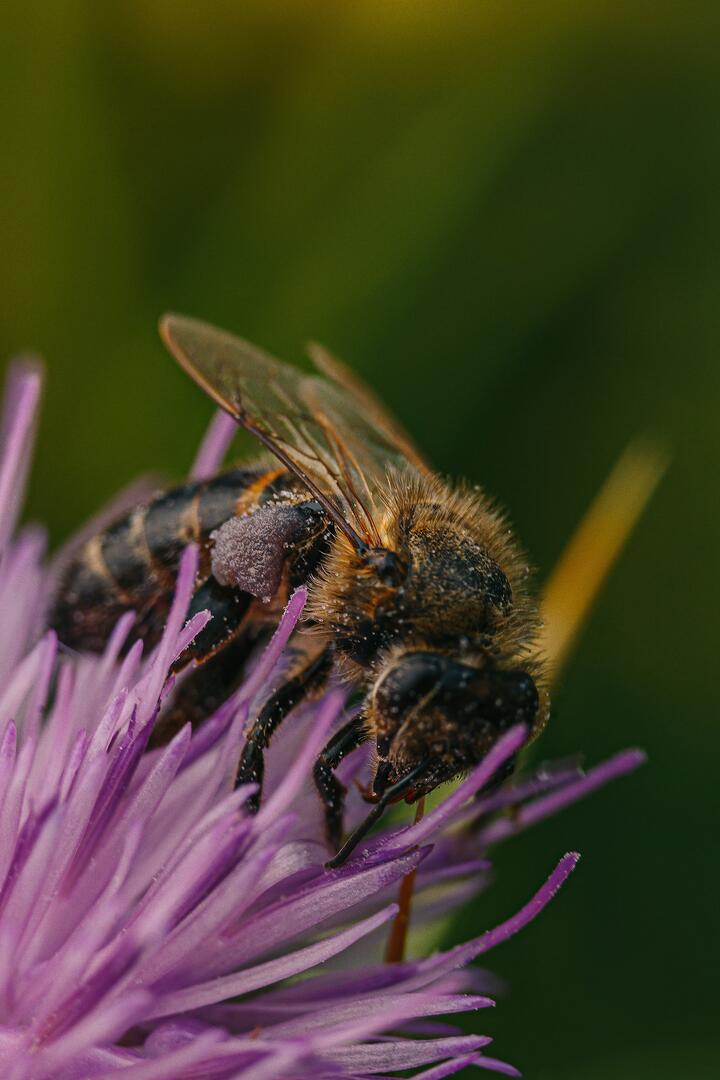 Photo by Raj Steven on pexels
Photo by Raj Steven on pexelsApproximately three hundred species of bumblebees are found in North Africa, North America, and northern Eurasia. They are also found in the mountains of some other regions of the globe. As you can see from the above, bumblebees prefer northern regions, which is not surprising, given that they are among the most cold-resistant insects. They can heat their body to a temperature of 40 degrees Celsius, which is necessary for the full life of the insect. To do this, bumblebees use frequent and rapid contraction of the chest muscles.
Thanks to their developed thermoregulation, they can fly out to collect nectar early in the morning, when the air is still too cold and other insects are still sitting in their hiding places. As a result, the first nectar goes to these frost-resistant toilers.
Thanks to the cannon on its body, the bumblebee controls the temperature of its body. Another factor that contributes to maintaining a normal body temperature is well-known, to all who have seen a bumblebee, a down on the body. Thanks to it, heat loss is reduced by half.
It is interesting that during the flight about 90% of all energy is converted into heat, and therefore the flying bumblebee has a constant temperature. At an ambient air temperature of 5 degrees, the bumblebee maintains a temperature of 36 degrees, and at 35 degrees – 45 degrees. For the same reason, bumblebees cannot fly at too high temperatures – they overheat.
However, despite all the “Nordic” nature of the bumblebee, it also has a cooling mechanism. For this purpose, in flight, the bumblebee releases a drop of liquid from its mouth, which evaporates and cools the insect’s head. When the bumblebee sits motionless, it is unable to maintain a high body temperature.
Flying bumblebee can reach speeds of about 18 kilometers per hour. These insects do not live alone, as is commonly thought, but in colonies. Each colony consists of 50-200 individuals. The colony consists of three types of bumblebees: males, worker bees (immature females), and females.
The construction of the nest begins in the spring, by the queen alone. An interesting difference between bumblebees and other social bees is that all larvae are nurtured and develop in the same chamber together. If conditions are normal, the female lays 200 to 400 eggs yielding worker bees, then proceeds to lay eggs from which males and females will grow.
Many years ago it was observed that a kind of “trumpeter” appears in bumblebee nests shortly before dawn. For a long time, it was thought that with its humming it rises the bees to work. But studies have shown that the “trumpeter” simply shivers from the cold because the soil temperature drops significantly in the hours before dawn.
The nest cools and the bumblebees have to work their pectoral muscles as hard as they can to maintain their temperature. The founder of the colony is one of the few over-wintered females fertilized in the fall (the female queen).
In the heat, you can also see a bumblebee fluttering its wings at the entrance to the bumblebee nest. This time, however, the bumblebee does this not to raise the temperature, but to ventilate the dwelling.
Interestingly, there are so-called cuckoo bumblebees, which lead a parasitic life, placing their larvae in other bumblebees’ hives. In addition, they mimic their coloration.
There is a common misconception that bumblebees fly, breaking the laws of aerodynamics. This misconception most likely originated in the early twentieth century, when they tried to apply lift calculations to bumblebees that were intended for airplanes. However, Cornell University physicist Zheng Jane Wang proved that the flight of insects does not violate any physical laws.
Did you like interesting facts about bumblebees? Share it with your friends.
Interesting Facts About Bumblebees
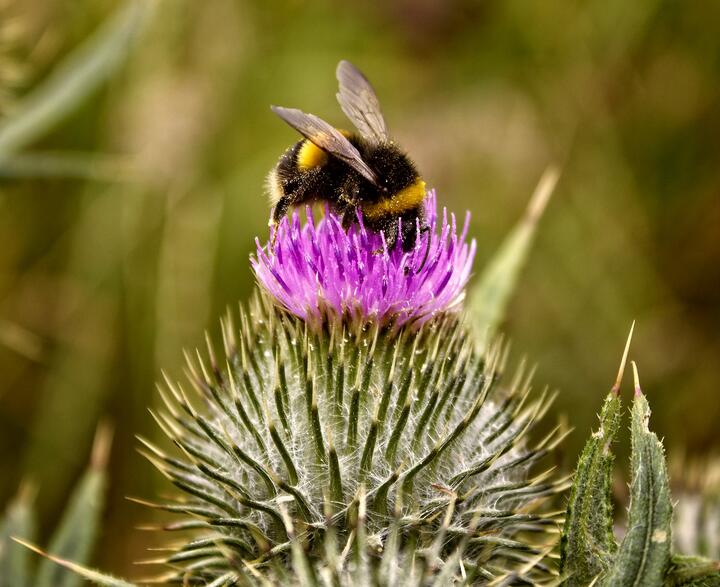 Photo by Michelle Reeves on pexels
Photo by Michelle Reeves on pexelsDid you know that bumblebees are the largest known insects? Their number is quite amazing – they can range as high as 500 feet. The genus Bombus has more than 250 species, and they are the only extant group in the tribe Bombini. Although there are fossils of several related genera, only the bumblebees survive today. This means that these amazing little creatures are the smallest stinging insects.
Unlike other insects, bumblebees can detect scents. Their ability to distinguish smells helps them improve their efficiency when looking for food. If you are trying to find flowers for your garden, you can try smelling their scent, and they will skip over flowers that they have already visited. They are also capable of breeding. If the queen dies, the workers of a honeybee colony can create a new queen. They pick a young larva, feed it royal jelly, and then watch it develop into a fertile queen.
In winter, bumblebees live in underground shelters, where they spend the winter. Their bodies are modified and their wings are extended to create a nest. In the spring, they will come out of their hibernation mode and build nests. They are only partially related to children. Their mother gives them half of their genes. The remaining half comes from their father. In fact, a single female bumblebee can have tens of thousands of hives.
In addition to their size, bumblebees have many personalities. In general, they are not aggressive and do not fight with other bees. While they are a social species, they do not store large amounts of honey. They typically store just enough to feed their larvae for a few days. One species of bumblebee is already extinct in Britain, as the British climate is changing.
Bumblebees live in colonies and are social. Habitat loss, pesticides and mechanization of agriculture have all contributed to the decline in the bumblebee population. Despite being aggressive, bumblebees are not aggressive. They only bite when threatened or injured, or to protect their nests. They can be found in many types of wild habitats, but are primarily threatened by humans.
Bumblebees are not aggressive, but they can sting multiple times. Their stinger is smooth and doesn’t come off. They do not attack humans, but they can sting their enemies. In addition to this, bumblebees are highly resistant to odors, so they are prone to a variety of allergies. There are several species of bumblebees that are considered invasive and have already disappeared in Britain.
Although bumblebees are very different from honey bees, they have many similarities. Their faces are similar to those of pigs, but their undersides are a light yellow color. They can survive in a range of habitats, including urban areas. They are similar to honey bees, but they look different. They are closely related to honey bees and have unique habits.
The queen bumblebee flies to a new location and chooses a suitable nesting site. A bumblebee colony consists of worker and drone bees. The drones and the queen are the only members of the hive and lay eggs. They are not aggressive, and they are not invasive to humans. The hive is also home to hundreds of other species, which include many species of bees.
The bumblebee population is relatively small and has only one queen. Their queen is the only female in the species, but they live with at least 50 other males. These bees are social and have complex family trees. The bumblebee population in a colony of 50 individuals is large, so they need to eat constantly. The sperm remains in the hive for several months before they are released.
Bumblebees have king and queen bees share the same genes. A bumblebee’s king and queen bee’s daughters are a third of the queen. These kings and queens are closely related to each other, but they do not always live near each other. In addition, the bumblebee’s body temperature is kept between 40 and 45 degrees Fahrenheit.
- LivestockWhat Do Llamas Eat?

- BirdsWhat Do Owls Eat In The Wild And At Home?By Nolan Foster
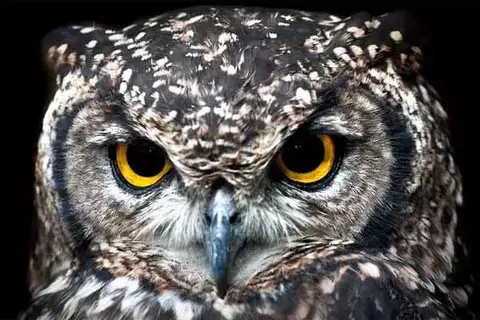
- Wildlife50 Most Interesting Facts About FoxesBy Murphy Scott

- BirdsHow Much Does A Raven Weigh?By Camilo Walker

- WildlifeAmazing Facts About Polar Bear CubsBy Evelyn Star

- BirdsWhere Parrots LiveBy Karla Miller
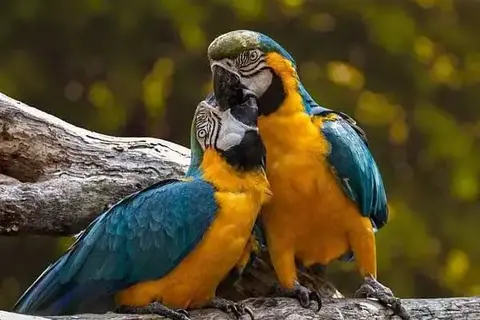
- Dogs10 Best Foods To Feed Your Senior DogBy Charlotte Green

- InsectsWhat Is Ladybug Food?By Noah Young
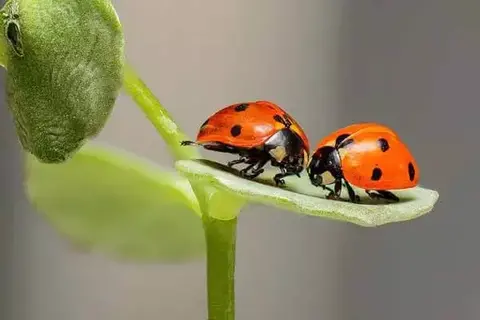
- RodentsHow Often Should Guinea Pigs Eat?By Nolan Foster

- BirdsWhat Do Hawks Eat In The Wild?By Khai Dove
